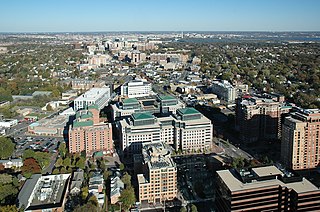
Arlington County, or simply Arlington, is a county in the U.S. state of Virginia. The county is located in Northern Virginia on the southwestern bank of the Potomac River directly across from Washington, D.C., the national capital.

The Alamo Drafthouse Cinema is an American cinema chain founded in 1997 in Austin, Texas, which is famous for serving dinner and drinks during the film, as well as its strict policy of requiring its audiences to maintain proper cinema-going etiquette. Sony Pictures Experiences acquired the chain in June 2024.

The Somerville Theatre is an independent movie theater and concert venue in the Davis Square neighborhood of Somerville, Massachusetts, United States. Over one hundred years old, the Somerville Theatre started off as a vaudeville house and movie theater. The theater has since transitioned and now operates as a live music venue and first-run movie theater. As a music venue, the theater has played host to many historic concerts, including the first of the two Last Dispatch concerts, two shows by Bruce Springsteen in 2003, and a performance by U2 in 2009. Recent live performances have included Ryan Adams & the Cardinals, Cursive, Norah Jones, The Jonas Brothers, Joan Baez, and the John Butler Trio.

The Mainstreet Theater, also commonly referred to as The Empire Theater, is a historic theater in downtown Kansas City, Missouri in the Power & Light District. The theater was landmarked and placed on the National Register of Historic Places in February 2007.
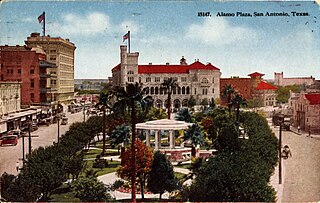
The Alamo Plaza Historic District is an historic district of downtown San Antonio in the U.S. state of Texas. It was listed on the National Register of Historic Places in 1977. It includes the Alamo, which is a separately listed Registered Historic Place and a U.S. National Historic Landmark.
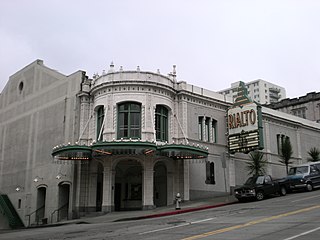
The Rialto Theatre in Tacoma, Washington was built in 1918 to showcase movies. Its design reflects the affluence following World War I. It reflects the character of a palace and is the result of efforts by entrepreneur Henry T. Moore and Tacoma architect Roland E. Borhek. Designed to hold 1500 patrons and retail space. The two-and-a-half-story structure is in the historic downtown of Tacoma. The area has long been associated with theaters and entertainment. The theater is freestanding, with a dramatic view on an incline with a classical façade sheathed of glazed white terra cotta. Both the interior and exterior retain most of the original design of Roland E. Borhek. The theater has an auditorium, proscenium with stage, a relocated projection booth, balcony, lobby, and commercial space. It has been altered with the removal of the storefronts and marquee. On the inside, the lobby's decorative ceiling has been hidden and the concession areas expanded.

The Alger Theater is a historic theater at 16451 East Warren Avenue in the MorningSide neighborhood of Detroit, Michigan. It is one of only two remaining intact and unchanged neighborhood theaters in the city of Detroit. It was listed on the National Register of Historic Places in 2005.

The Sparrow House is an historic house at 35 Arlington Street in the Woodfords Corner and Back Cove neighborhood of Portland, Maine. Built in 1852, it is a well-preserved example of Gothic Revival architecture. It was listed on the National Register of Historic Places in 1982.

The Outing Club is located in the central part of Davenport, Iowa, United States. It has been listed on the National Register of Historic Places since 1977. In 1985 it was included as a contributing property in the Vander Veer Park Historic District.

The Wheeler Opera House is located at the corner of East Hyman Avenue and South Mill Street in Aspen, Colorado, United States. It is a stone building erected during the 1890s, from a design by Willoughby J. Edbrooke that blends elements of the Romanesque Revival and Italianate architectural styles. In 1972 it became the first property in the city to be listed on the National Register of Historic Places, and the second in Pitkin County. The upstairs auditorium hosts a number of events every year, ranging from nationally prominent music and comedy acts and some of the Aspen Music Festival's events to productions by local community groups.

The University Club of Albany, New York, was a social club founded in 1901 that closed in 2022. It was most recently housed in a Colonial Revival brick building at the corner of Washington Avenue and Dove Street.
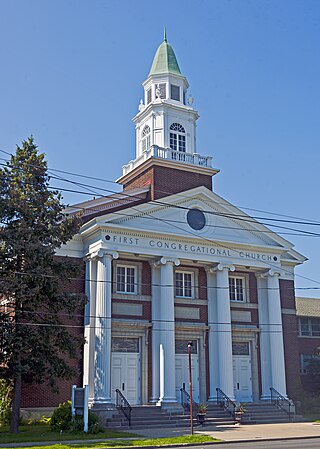
The First Congregational Church of Albany, also known as The Ray Palmer Memorial, is located on Quail Street in the Woodlawn section of Albany, New York, United States. It is a brick building in the Colonial Revival architectural style built in the 1910s and expanded half a century later. In 2014 it was listed on the National Register of Historic Places.

The New Center Commercial Historic District is a commercial historic district located on Woodward Avenue between Baltimore Street and Grand Boulevard in Detroit, Michigan. It was listed on the National Register of Historic Places in 2016.

The Daryl Roth Theatre is an off-Broadway performance space at 101 East 15th Street, at the northeast corner of the intersection with Union Square East, near Union Square in Manhattan, New York City. The theater, which opened in 1998, is housed in the four-story Union Square Savings Bank building, which was designed by Henry Bacon and built between 1905 and 1907.

Ibex House is an eleven storey Art Deco office building on the east side of the City of London, just to the north of the Tower of London. It was designed by Fuller, Hall and Foulsham in the Streamline Moderne style, with curved corners and distinctive horizontal bands of faience cladding and black-framed fenestration. Construction started as a speculative development in 1935 and the building was completed in 1937. It became a Grade II listed building in 1982.

889 Broadway, also known as the Gorham Manufacturing Company Building, is a Queen Anne style building located at Broadway and East 19th Street in the Flatiron District of Manhattan in New York City, within the Ladies' Mile Historic District. Built in 1883–1884, it was designed by Edward Hale Kendall.
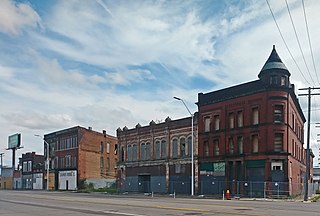
The Michigan Avenue Historic Commercial District in Detroit is a group of commercial buildings located along the south side of two blocks of Michigan Avenue, from 3301–3461. This section of buildings is the most intact collection along this stretch of Detroit's Michigan Avenue. The district was listed on the National Register of Historic Places in 2020.

The Metro Theater is a defunct movie theater at 2626 Broadway on the Upper West Side of Manhattan in New York City. It was designed by architecture firm Boak and Paris and built between 1932 and 1933. The theater is designed in the Art Deco style and originally contained 550 seats. Although the theater's interior was demolished after it was closed in 2005, the original facade remains intact and is a New York City designated landmark.

The Downtown Paris Historic District, in Paris, Kentucky, in Bourbon County, Kentucky, is a historic district which was listed on the National Register of Historic Places in 1989.

The Ambassador Theater is a historic Streamline Moderne movie theater on Liberty Heights Avenue in the Howard Park section of Baltimore, Maryland. It is listed on the National Register of Historic Places and is a designated Baltimore City Landmark.























